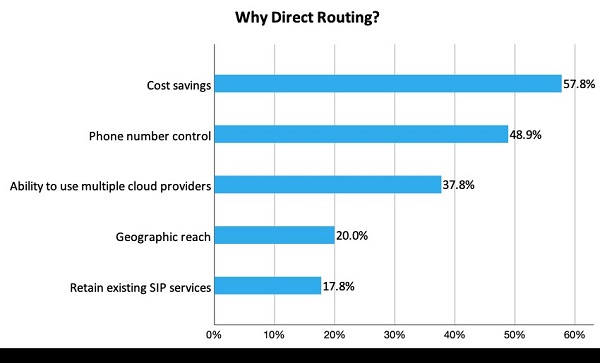Metrigy’s recently published Workplace Collaboration: 2021-22 global research study of 476 organizations found that more than 70% of those adopting Microsoft Teams Phone System are using Direct Routing to connect Teams to the PSTN. Direct Routing allows Teams users to leverage their existing or new session border controllers and SIP trunking services rather than rely on Microsoft’s Calling Plan for phone numbers and PSTN access. Direct Routing adopters cite the following reasons for using it, rather than Calling Plan:
- Cost Savings - As I noted in last year’s related NoJitter post, our research finds that those using Direct Routing spend an average of $7.91 on PSTN connectivity compared to either $12 for Microsoft’s domestic plan, or $24 for its international calling offering. These costs don’t include procurement, maintenance, and management of SBCs, but they do show potential for broad savings for PSTN access compared with the fixed per-month fee associated with Calling Plan that includes a block of calling minutes that often go unused
- Phone Number Control – Direct Routing allows a company to maintain control of its phone numbers and dial plan rather than have to port them to Microsoft, often enabling faster migration to Teams Phone System by eliminating the time and complexity of number porting
- Ability to use multiple cloud providers – About 15% of companies in our study use more than one calling platform, and many have their own on-premises or cloud-based contact centers. Direct Routing allows for fine-grained policy routing of incoming calls to multiple systems
- Geographic Reach – While Microsoft continues to expand Calling Plan availability, it still isn’t available everywhere, leading some international organizations to rely on Direct Routing for local calling in underserved markets
- Retaining existing SIP services – Many organizations have multi-year contracts with SIP providers. The ability to continue to support these SIP services removes a barrier to Teams Phone System adoption
In response to growing adoption of both Teams Phone System and Direct Routing, enterprise options have greatly expanded. Two examples include:
- Operator Connect - a new capability, announced at Microsoft’s recent Ignite conference, within Teams Operator Console that allows customers to directly configure Direct Routing services from several Microsoft partners including BT, Intrado, NTT, NuWave, Orange Business Services, PureIP, Rogers, Swisscom, Tata Communications, Telenor, T-Mobile, and Verizon. Expect additional providers to be added to Operator Connect in the future
- UCaaS Provider Direct Routing – Now available from companies including RingCentral and 8x8, these offerings enable Teams users to make calls, and access UCaaS calling features, from within the Teams client
In addition to these newer options, those using or considering the Teams Phone System have a variety of additional offerings including packaged solutions combining E911 and Direct Routing from Bandwidth, bundled offerings including managed SBCs from SIPPIO, and managed offerings from telecom providers including AT&T, Lumen, and many more.
Beyond that, Microsoft’s recent acquisition of Metaswitch sets the stage for carriers currently offering UCaaS services based on Metaswitch’s platform to integrate those offerings with Teams, in a similar fashion to how BroadSoft-based carriers can now achieve similar integration with Cisco Webex.
Additionally, organizations can still roll their own Direct Routing deployments using certified session border controllers with their choice of SIP provider.
Thanks to the rapid development of the Teams Direct Routing ecosystem, Microsoft Teams Phone System has an increasing array of options for PSTN connectivity. As a result, IT leaders should:
- Evaluate Direct Routing as an alternative to Microsoft Calling Plan for PSTN connectivity
- If currently using or planning to use UCaaS providers offering Teams Direct Routing services, or if needing calling features beyond those offered within Teams Phone System, consider Direct Routing services offered by UCaaS providers
- If using or planning to use SIP trunking services offered by Operator Connect partners, take advantage of the ability to perform configuration management tasks within the Teams Operator Console
- Evaluate additional Direct Routing providers, both emerging and legacy, based on cost, features, geographic reach, and management capabilities











